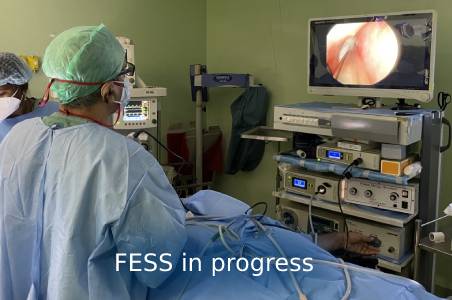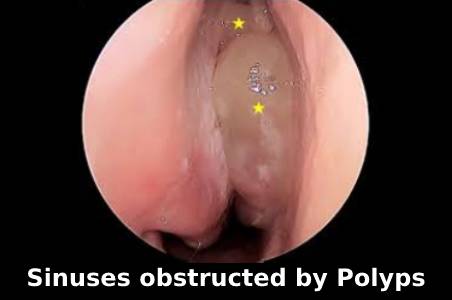NASAL SURGERIES
Surgery for Deviated Nasal Septum (DNS)
The nasal septum forms the partition between the two nasal cavities. Its partly cartilagenous ( in its front portion) & partly bony ( in its back portion). Its very rare to find a person with a straight vertical septum. In other words a minor deviation is the rule. A significantly Deviated septum can obsruct nasal breathing.

Symptoms due to DNS could be:
- Nasal Obstruction
- Sinusitis due to obstruction of the sinuses
- Disturbed breathing during sleep with snoring
Surgery for correcting a DNS is called Septoplasty.
In Septoplasty the deviated portions of the cartilage & bone are either removed ( without removing too much) or reshaped. The Endoscope comes in as a handy tool to perform Septoplasty.
Endoscopic removal of Adenoids
The Adenoid is a Lymphoid tissue like the Tonsils in the throat. Physiological enlargement of the Adenoid occurs in childhood & early adolescence.
The Adenoid tissue may however be enlarged beyond the physiological limits. The Enlargement could be due Allergy, Infection or an exagerrated enlargement which occurs during childhood.
Enlarged adenoids can obstruct nasal breathing or predispose one to sinus infections. A significant enlargement of the Adenoid & Tonsils cause cause heavy snoring with Obstructive sleep apnoea. An adenoid enlargement is also a common cause for the Glue Ear ( discussed earlier) in children.
An enlarged Adenoids predisposing to the above conditions needs to be removed. Endoscopic removal of the Adenoids ensures complete removal. There are different ways to Endoscopically remove the Adenoids.When the Tonsil is also enlarged or Infected, a concurrent removal of the Tonsil ( Tonsillectomy) is also performed.
Endoscopic surgery for Chronic Sinusitis
The new term is Chronic Rhinosinusitis ( CRS).
The patient having CRS has one or more of the following complaints for more than 3 months duration:
- Nasal Congestion
- Nasal discharge
- Mucus dripping in the throat
- Facial pressure
- Disturbances in smell
A conservative treatment is given for a reasonable period of time before doing any further tests.The conservative treatment includes the use of a Steroid nasal spray along with Antibiotics ( if needed) & antihistamines (if needed). If the conservative treatment fails to provide adequate benefit, the following diagnostic tests are done.
- Diagnostic Nasal Endoscopy
- Radiology ( CT Scan Imaging)
Following the above diagnostic tests, the patient may be offered surgery called Functional Endoscopic Sinus Surgery ( FESS) The obstructed sinuses are opened up. The extent of surgery is dictated by the Diagnostic tests partcularly Imaging.

How does FESS help?
- It removes blockage & facilitates drainage of the sinuses
- It improves ventilation of the sinuses which is crucial to maintain normal status of the sinuses
- It provides a route for administration of Steroid nasal spray. Steroid nasal spray are required following FESS in patients treated for Nasal Polyps

Endoscopic closure of Cerebrospinal fluid leak ( CSF) through the nose
CSF is a watery fluid which keeps circulating around the brain & the spinal cord. The rate of secretion of CSF roughly approximates its rate of absorption keeping the pressure constant.
The base of skull seperates the roof of the nasal cavity & the sinuses from the brain.When there is a defect in this barrier CSF may start leaking from the nose. In some the pressure inside the cranial cavity may be higher than normal & this may trigger the leak.
The Diagnosis is quite evident when the patient says there is a clear watrey discharge from the nostrils. The discharge increases whenever the patient bends forward.
Conservative treatment is given a trial. This includes bedrest, avoidance of straining while voiding urine or stools & medicines to reduce CSF pressure. A decision to take up the patient for surgical closure of the defect is taken if conservative measures fail. The leak if left unattaended can lead to infection in the skull called meningitis.
Surgery is done after doing imaging ( Radiology) which includes a CT Scan. The site of leak is identified & closed by using patient’s own tissue. The Endoscope is again a valuable tool in this surgery.
